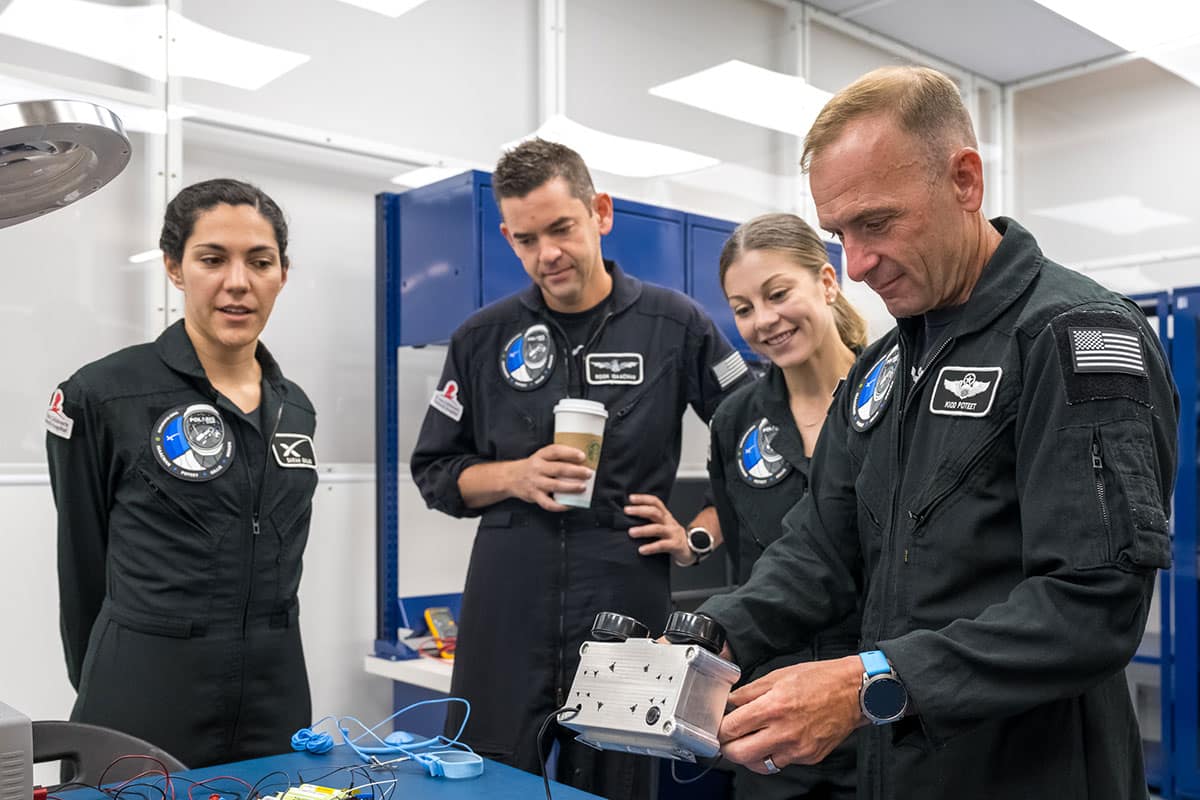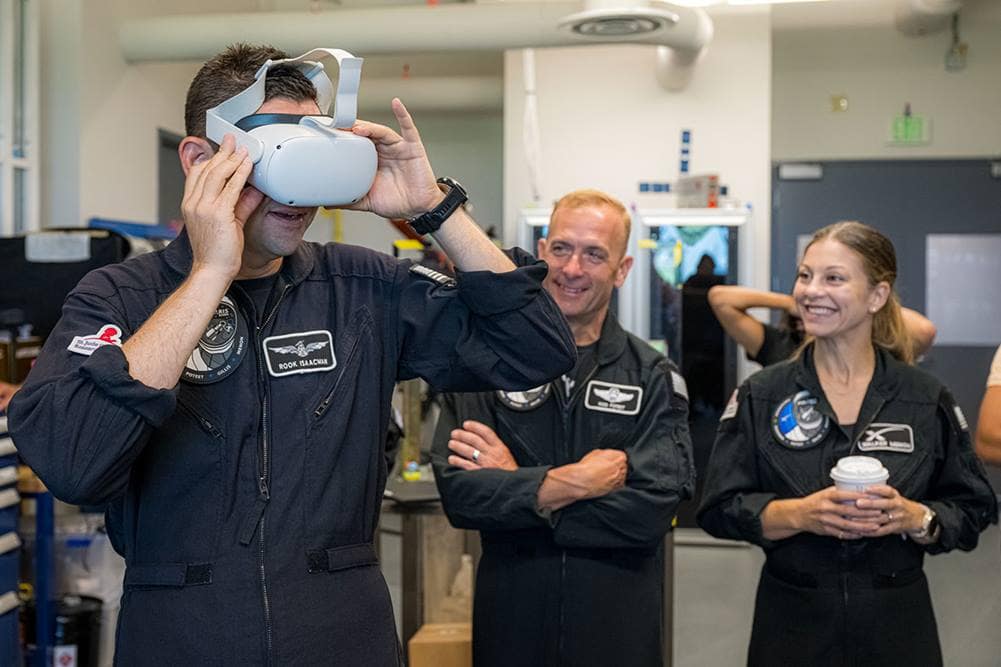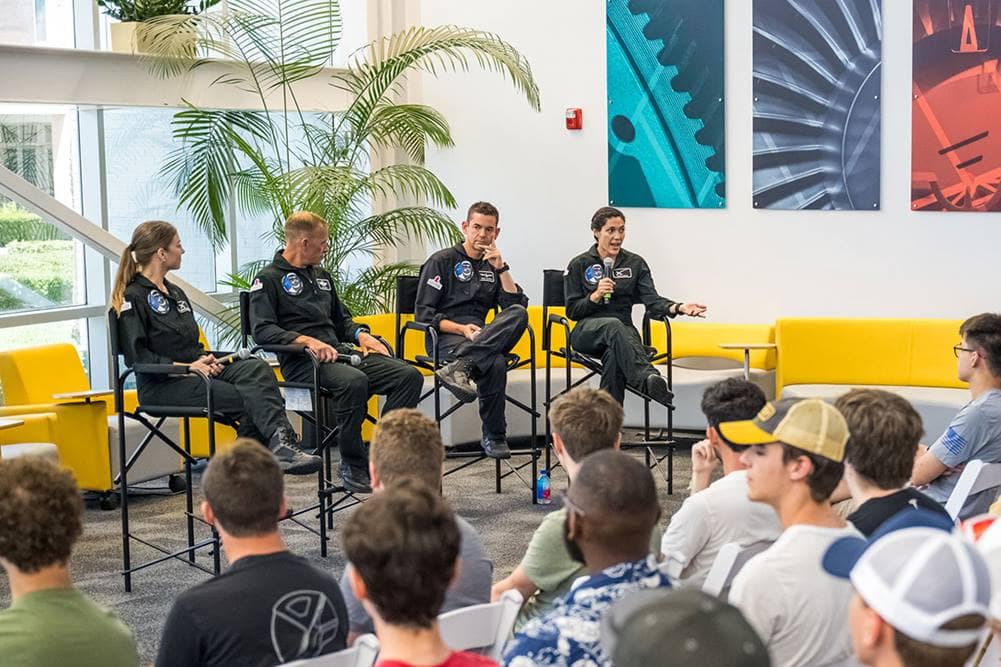Polaris Dawn Crew Meets Eagles, Inspects Camera System to Use in 2024 Space Mission

While engineering a camera to capture a spacewalk, notoriously one of the most dangerous feats carried out by astronauts, a team of Embry-Riddle Aeronautical University students focused on a single button.
Dubbed LLAMAS, for Literally Looking at More Astronauts in Space, the camera project is the product of a collaboration with alumnus Jared Isaacman, who helmed SpaceX’s Inspiration4 mission, the first privately crewed spaceflight.
Isaacman is now commander of SpaceX’s Polaris Dawn mission, set to launch in 2024. During that mission’s planned five days in orbit, at least one crewmember will exit the Dragon capsule to perform the world’s first spacewalk by a non-government-employed astronaut. The camera now being built — by graduate and undergraduate students led by Dr. Troy Henderson, director of Embry-Riddle’s Space Technologies Lab — will capture it all.
But first, the team had to perfect the button that starts the camera’s recording. SpaceX has a mantra of “no accidental pushes” for safety, meaning that the crew must have minimal interaction with the Dragon capsule, said Daniel Lopez, a senior studying Mechanical Engineering.
The students puzzled over the button’s design — its size, shape and feel. To test each version’s functionality, they layered on ski gloves, said Taylor Yow, who is pursuing her master’s degree in Aerospace Engineering.
“You don’t think about it, but a button can be so important,” Yow said.
After trying several prototypes, the team settled on a raised black button about an inch in diameter. When pressed, a white LED illuminates, giving a visual indication that the camera is recording.
Last month, the Polaris Dawn astronauts visited Embry-Riddle. When the time came for them to handle the camera, they gave the button a “go” for launch.

Polaris Dawn Mission Commander Jared Isaacman, an alumnus, looks through a virtual reality headset to see test footage from the LLAMAS camera unit. (Photo: Polaris Program/John Kraus)
Retrofitted into a mobility-aid mount near the front hatch window, the LLAMAS camera unit is the first piece of hardware not built by SpaceX to be mounted inside a Dragon capsule. Getting it right has required weekly meetings with the SpaceX team. The students also visited SpaceX’s headquarters multiple times, testing the unit inside a Dragon capsule simulator. They received feedback from the SpaceX engineering team and successfully determined how to best mount the camera to the capsule.
“As a result of LLAMAS, we have new insight into building hardware for spaceflight, and our students have the opportunity to continue to work with both SpaceX and Polaris,” said Henderson, associate professor of Aerospace Engineering.
The LLAMAS camera unit will capture a 180-degree view of the entire spacewalk from the capsule's interior, including the opening of the hatch and a crew member passing through it into space.
“We will be filming for about two and a half to three hours, so hopefully, the footage that we get back will show the whole experience,” Yow said.
People back on Earth will also be able to immerse themselves in the spacewalk experience. The stereoscopic imagery collected by the LLAMAS unit will be viewable via virtual reality (VR) headsets. During the Polaris Dawn crew’s recent visit, the students showed them the 3D VR software for the first time.
In addition to filming the spacewalk, the LLAMAS camera unit will provide data on the first-of-their-kind spacesuits designed by SpaceX to protect the crew during extravehicular activity (EVA). The unit’s thermal imaging camera will record the spacesuits’ surface temperature, and a dosimeter will record data on the radiation environment, one of the major hazards of human spaceflight.
Plenty still needs to be done to the LLAMAS camera between now and next year’s launch. The unit must pass a battery of tests to show it meets safety requirements and can withstand the extremes of spaceflight and space’s harsh environment. This includes vibration testing, vacuum testing and temperature cycle testing. The team is also finalizing the camera’s software.
“If the qualification unit has any problems, we redesign that component before we build our flight unit,” Lopez said. “We’re 90% of the way there. The really exciting thing for me is when we’ll see the camera operating exactly as it’s supposed to.”

Students listen to the Polaris Dawn crew speak about their mission, which will feature the first spacewalk by an astronaut not working for the government. Speaking to the audience is Sarah Gillis, mission specialist. Next to her (from right) are Jared Isaacman, mission commander; Scott Poteet, mission pilot; and Anna Menon, mission specialist and medical officer. (Photo: Polaris Program/John Kraus)
Set Up for Success
During a recent visit to Embry-Riddle, the four SpaceX astronauts set up in the College of Aviation to speak to a packed crowd of students about the Polaris Dawn mission.
Crewmembers Scott Poteet, a retired Air Force lieutenant colonel and the mission’s pilot; Sarah Gillis, a lead space operations engineer at SpaceX who oversees astronaut training and will serve as a mission specialist; and Anna Menon, a SpaceX lead space operations engineer who will serve as medical officer, also answered questions.
Goals for the mission include several firsts for SpaceX and space exploration. The crew will attempt to reach an altitude of 870 miles — higher than any previous SpaceX Dragon mission and farther from Earth than any previous crewed mission outside of NASA’s Apollo lunar missions.
All four crew members will be exposed to the vacuum of space while wearing SpaceX’s pressurized EVA spacesuits.
They will also test a laser-based connection between SpaceX’s Starlink satellites and the spacecraft, which is incredibly challenging since “you have two objects traveling 17,500 miles per hour” that need to establish a link, mission specialist Gillis said. Such networking capabilities will be needed for long-term exploration from the moon or Mars, she added.
Some 40 novel research experiments will be carried out over the five days in orbit. One area of focus is what’s known as Spaceflight Associated Neuro-ocular Syndrome (SANS), a phenomenon where astronauts spending long periods in weightlessness begin to experience blurry vision, nausea and headaches.
Contact lenses worn by the astronauts will provide pressure data, and a three-dimensional ultrasound device will capture images of their optic nerves. The optic nerve — a bundle of nerve fibers in the back of the eye that carries information to the brain — has been shown to swell in astronauts who spend long periods in microgravity.
“We’re hoping to better understand what are these mechanisms happening under the surface that are changing astronauts’ eyesight,” Menon said.
The crew also described their rigorous training for the spacewalk: complex scuba dives and skydives, zero gravity and fighter jet flights, a climb of Ecuador’s Mount Cotopaxi, and two days of living together in a pressure chamber.
“It's so imperative that we get as much of these stressors here on Earth, in environments that have real consequence, before we go up into space,” Isaacman said.
The crew also answered questions on everything from the scaling of spacesuit technology to what it’s like to leave Earth on the Falcon 9 rocket.
“We are going full steam ahead into space, and there are virtually an infinite number of questions,” Isaacman said. “So if you are going through an Aerospace Engineering program in the years ahead, I hope that you are charged up.”
